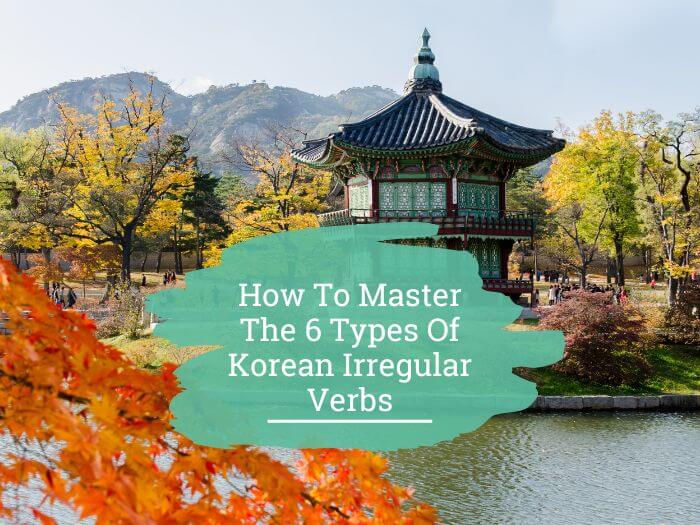When you're learning Korean, at some point, you'll have to tackle not only verbs in Korean, but Korean irregular verbs.
Verbs are a very important part of learning a new language, as without you’d quite literally be unable to do anything!
If you’re not familiar with the concept of irregular verbs, then prepare yourself, because there are many in Korean!
In this article you're going to discover the difference between regular and irregular verbs, along with some examples and the rules you need to know to master Korean irregular verbs.
Pro Tip
By the way, if you want to learn Korean fast and have fun while doing it, my top recommendation is Korean Uncovered which teaches you through my fun, unique and effective StoryLearning® method.
If you’re ready to get started, click here for a 7-day FREE trial.
Table of Contents
What Is Verb Conjugation Anyway?

The phrase verb conjugation may sound a little scary, but there’s no need to be afraid. Verbs change their form depending on what they need to express.
For example, if you want to say that you did something in the past, then verbs will take the past tense form. This is one of the most common verb conjugations that we use in everyday life.
Korean verb conjugation can be a little daunting, because a lot of Korean grammar is dependent on conjugation.
Conjugations can change the meaning of a sentence completely. In Korean, there are some ways of conjugating verbs that might be unfamiliar to you. One of these is conjugating according to formality.
In Korean, addressing somebody who is senior to you (e.g., a teacher or boss) using low formality can be seen as rude and inappropriate. This makes it especially important that you are aware of different conjugation patterns.
Verbs In Korean & Irregular Verbs

You need to understand how verbs work in Korean, because they function differently from English.
In English, “cute” is classified as an adjective, a describing word. In Korean, these are called descriptive verbs, as they can be used alone without the addition of a phrase such as “to be”.
So, in Korean, the word “cute” 귀엽다 automatically carries the meaning of “to be cute”. This is one of the key differences between verbs in English and verbs in Korean, so don’t forget it!
It might be unusual to get used to at first, but knowing this information is very helpful in learning Korean.
When we’re thinking about verbs in English, we can notice general rules about how certain forms are created. For example, -ed typically indicates the past tense, and -ing the present continuous.
Many verbs behave according to these rules – “cooking/cooked”, “cleaning/cleaned”, “playing/played” – but some don’t. The past tense of “ate” isn’t “aten”.
Ever wondered why this happens? This is because “ate” is an example of an irregular verb. It doesn’t follow the typical conjugation patterns.
To boost your knowledge of Korean verb conjugation, you first must identify if the verb ends in a vowel or a consonant, as this is the main factor in conjugation.
On top of this, you also must think about if the verb conjugation begins with a vowel or a consonant. You're about to go deeper into this, so don’t worry if this is going over your head right now!
Regular Verbs In Korean

If you’ve searched for a verb in a Korean dictionary, you’ll realise that they look a little different from how they are spoken. This is the most basic form of the verb without any conjugation.
The verb base is important to have in mind when conjugating, and in Korean, this is the part of the verb that comes before 다.
In the verb “to drink” 마시다, the verb base is 마시-, and you first have to drop the 다 to be able to conjugate.
Conjugating regular verbs is simple, as they follow typical and predictable patterns.
As it’s the most common formality style in Korean speech, let's to look at some regular verbs which end in vowels in the table below and how they conjugate using tense:
| Verb | Present | Present Continuous | Past | Future |
| 가다 | 가요 gayo (to go) | 가고 있어요 gago isseoyo (to be going now) | 갔어요 gasseoyo (went) | 갈 거예요 gal geoyeyo (will go) |
| 보내다 | 보내요 bonaeyo (to send) | 보내고 있어요 bonaego isseoyo (to be sending now) | 보냈어요 bonaesseoyo (sent) | 보낼 거예요 bonael geoyeyo (will send) |
| 오다 | 와요 wayo (to come) | 오고 있어요 ogo isseoyo (to be coming now) | 왔어요 wasseoyo (came) | 올 거예요 ol geoyeyo (will come) |
| 배우다 | 배워요 baewoyo (to learn) | 배우고 있어요 baeugo isseoyo (to be learning now) | 배웠어요 baewosseoyo (learnt) | 배울 거예요 baeul geogeyo (will learn) |
| 달리다 | 달려요 dallyeoyo (to run) | 달리고 있어요 dalligo isseoyo (to be running now) | 달렸어요 dallyeosseoyo (ran) | 달릴 거예요 dallil geoyeyo (will run) |
| 주다 | 줘요 jwoyo (to give) | 주고 있어요 jugo isseoyo (to be giving now) | 줬어요 jwosseoyo (gave) | 줄 거예요 jul geoyeyo (will give) |
| 쓰다 | 써 sseo (to write) | 쓰고 있어요 ssuego isseoyo (to be writing now) | 썼어요 sseosseoyo (wrote) | 쓸 거예요 sseul geoyeyo (will write) |
These verbs are regular because they follow patterns in predictable ways according to a set of rules. “To drink” 마시다 conjugates in the same way as “to run” 달리다 as both end in ㅣ.
Next, let's look at how regular verbs that end in a consonant function:
| Verb Base | Present | Present Continuous | Past | Future |
| 받다 | 받아요 badayo (to receive) | 받고 있어요 battgo isseoyo (to be receiving now) | 받았어요 baddasseoyo (received) | 받을 거예요 badeul geoyeyo (will receive) |
| 먹다 | 먹어요 meogeoyo (to eat) | 먹고 있어요 meokgo isseoyo (to be eating now) | 먹었어요 meogeosseoyo (ate) | 먹을 거예요 meogeul geoyeyo (will eat) |
| 읽다 | 읽어요 ilgeoyo (will read) | 읽고 있어요 ikgo isseoyo (to be reading now) | 읽었어요 ilgeosseoyo (read) | 읽을 거예요 ilgeul geoyeyo (will read) |
Again, you can see that the verbs follow certain patterns depending on which vowel or consonant they end in.
Introducing Korean Irregular Verbs

Verb conjugation in Korean doesn’t seem so hard, right? Well, this is where things get tricky.
Korean irregular verbs have their own set of rules, even if they have the same vowel/consonant ending as regular verbs.
This means that “to listen” 듣다 and “to receive” 받다 conjugate in completely different ways in the present tense, even though they both end in ㄷ. 받다 becomes 받아요 in the present tense, but 듣다 becomes 들어요 instead, as the ㄷ becomes ㄹ.
They may not conjugate the same way as regular verbs, but fortunately Korean irregular verbs do have rules, so let’s dig in!
Irregular ㄷ Verbs

Most verbs that end in ㄷ follow the usual rules… but there are some that don’t. There’s no real way of knowing at first glance whether a verb is regular or irregular.
But as you follow the rules of StoryLearning and read books in Korean you'll soon get the hang of them.
Irregular ㄷ verbs only behave irregularly when the verb ending begins in a vowel. The term verb ending refers to the conjugation that will be attached to the verb base.
The present tense is the most common example (아/어요) of a verb ending beginning with a vowel. When ㄷ meets a verb ending beginning with a vowel, it becomes ㄹ. When ㄷ meets a verb ending beginning with a consonant, it conjugates as a regular verb.
- 듣다 > 들어요 (to listen)
- 듣다 > 듣고 있어요 (to be listening now)
| Irregular Verb | Present | Present Continuous | Past | Future |
| 듣다 | 들어요 deureoyo (to listen) | 듣고 있어요 deutgo isseoyo (to be listening now | 들었어요 deurosseoyo (listened) | 들을 거예요 deureul geoyeyo (will listen) |
| 묻다 | 물어요 mureoyo (to ask) | 묻고 있어요 mutgo isseoyo (to be asking now) | 물었어요 mureosseoyo (asked) | 물을 거예요 mureul geoyeyo (will ask) |
| 걷다 | 걸어요 georeoyo (to walk) | 걷고 있어요 geotgo isseoyo (to be walking now) | 걸었어요 georeosseoyo (walked) | 걸을 거예요 georeul geoyeyo (will walk) |
Sample Sentences
- 저는 록 음악을 듣는 것을 좋아해요.
- Jeoneun rong eummageul deunneun geoseul joahaeyo.
- I like listening to rock music.
- 저는 어젯밤에 록 음악을 들었어요.
- Joneun eojetbame rong eumageul deureosseoyo.
- I listened to rock music last night.
- Joneun eojetbame rong eumageul deureosseoyo.
Irregular ㅂ Verbs

There are many different irregular ㅂ verbs in Korean, but fortunately, they tend to follow similar patterns.
These are probably some of the most confusing Korean irregular verbs out there, but with some practice you’ll get the hang of them.
These verbs only conjugate irregularly when the verb ending begins with a vowel. When this happens, you drop the ㅂ, and add 우 + 어.If the conjugation begins with a consonant, they behave regularly.
- 맵다 > 매워요 (spicy)
Here are some common irregular verbs that follow this pattern:
| Irregular Verb | Present | Past | Future |
| 맵다 | 매워요 maewoyo (to be spicy) | 매웠어요 maewosseoyo (was spicy) | 매울 거예요 maeul geoyeyo (will be spicy) |
| 귀엽다 | 귀여워요 gwiyeowoyo (to be cute) | 귀여웠어요 gwiyeowosseoyo (was cute) | 귀여울 거예요 gwiyeoul geoyeyo (will be cute) |
| 돕다* | 도와요 dowayo (to help) | 도왔어요 dowasseoyo (helped) | 도 울거예요 do ulgeoyeyo (will help) |
* When 돕다 is conjugated with verb endings that begin with 아/어/여, 오 is added instead of 우. Take care to remember this!
Sample Sentences:
- 재 친구가 집 이사를 도와줬어요.
- Jae chinguga jim isareul dowajwosseoyo.
- My friend helped me move house.
- Jae chinguga jim isareul dowajwosseoyo.
- 저는 재 친구를 돕고있어요.
- Jeoneun jae chingureul dopgo isseoyo.
- I am helping my friend.
- Jeoneun jae chingureul dopgo isseoyo.
Irregular ㅅ Verbs

Fortunately, most ㅅ verbs are regular, and there are a few that are irregular, so this makes them some of the easiest to learn. The verbs only behave irregularly when the conjugation begins with a vowel.
In this case, ㅅ is dropped from the verb base. Another important note is that vowels don't combine when conjugating irregular ㅅ verbs. For example, rather than “to pour” 붓다 becomes 부어요 in the present tense, instead of 붜요.
| Irregular Verb | Present | Present Continuous | Past | Future |
| 긋다 | 그어요 geueoyo (to draw) | 긋고 있어요 geutgo isseoyo (to be drawing now) | 그었어요 geueosseoyo (drawn) | 그을 거예요 geueul geoyeyo (will draw) |
| 낫다 | 나아요 naayo (to get better) | 낫고 있어요 natgo isseoyo (to be getting better now) | 나았어요 naasseoyo (gotten better) | 나을 거예요 naeul geoyeyo (will get better) |
Sample Sentences
- 몸이 낫고있어요.
- Momi natgo isseoyo.
- I’m feeling better.
- Momi natgo isseoyo.
- 빨리 나으세요.
- Ppali naeuseyo.
- Get well soon.
- Ppali naeuseyo.
Irregular ㄹ Verbs

Any verb or Korean adjective that ends in ㄹ behaves irregularly in Korean. If any Korean irregular verbs are going to give you a headache, it’ll be irregular ㄹ verbs, so we’re going to take a bit of different approach to these ones.
When the verb ending begins with ㄴ, ㅂ, or ㅅ, the ㄹ is dropped, because ㄹ doesn’t like these consonants. It does like the others though, as in the present continuous of “to be living” 살고 있어요 it stays!
The funny thing here is unlike the other Korean irregular verbs we’ve looked at, irregular ㄹ verbs behave regularly when conjugating with verb endings that begin in vowels.
| Irregular Verb | Present | Present Continuous | Past | Future |
| 알다 | 알아요 arayo (to know) | 알고 있어요 algo isseoyo (to know now) | 알았어요 arraseoyo (known) | 알 거예요 al geoyeyo (will know) |
| 만들다 | 만들어요 mandeureoyo (to make) | 만들고 있어요 mandeulgo isseoyo (to be making now) | 만들었어요 mandeureosseoyo (made) | 만들 거예요 mandeul geoyeyo (will make) |
| 놀다 | 놀아요 norayo (to play) | 놀고 있어요 nolgo isseoyo (to be playing now) | 놀았어요 norasseoyo (played) | 놀 거예요 nol geoyeyo (will play) |
Sample Sentences
- 저는 김치를 만들고있어요.
- Jeoneun gimchireul mandeulgo isseoyo.
- I am making kimchi.
- Jeoneun gimchireul mandeulgo isseoyo.
- 저는 다음주에 김치를 만들거예요.
- Jeoneun daeumjue gimchireul mandeul geoyeyo.
- I will make kimchi next week.
- Jeoneun daeumjue gimchireul mandeul geoyeyo.
- 누구인지 아세요?
- Nuguinji aseyo?
- Do you know who that is?
- Nuguinji aseyo?
Irregular 르 Verbs

You’re now on the penultimate group of Korean irregular verbs! Verbs that end with 르 in Korean behave irregularly. These verbs behave regularly when conjugating with 아/어.
When this happens, the ㅡ is dropped and the ㄹ is doubled. For example, “to not know” 모르다 is conjugated as 몰라요 in the present tense.
| Irregular Verb | Present | Present Continuous | Past | Future |
| 부르다 | 불러요 Bulleoyo (to sing) | 부르고 있어요 Bureugo isseoyo (to be singing now) | 불렀어요 Bulleosseoyo (sang) | 부를 거예요 Bureul geoyeyo (will sing) |
| 자르다 | 잘라 Jallayo (to cut) | 자르고 있어요 Jareugo isseoyo (to be cutting now) | 잘랐어요 Jallasseoyo (cut) | 자를 거예요 Jareul geoyeyo (will cut) |
| 모르다 | 몰라요 Mollayo (to not know) | 모르고 있어요 Moreugo isseoyo (to not know right now | 몰랐어요 Mollasseoyo (didn't know) | 모를 거예요 Moreul geoyeyo (will not know) |
Sample Sentences
- 저는 그것을 몰랐어요.
- Jeoneun geugeoseul mollasseoyo.
- I didn’t know that.
- Jeoneun geugeoseul mollasseoyo.
- 학생들은 사고에 대해 전혀 모르고있어요.
- Haksaengdeureun sagoe daehae jeonhyeo moreugo isseoyo.
- The students know nothing about the incident.
- Haksaengdeureun sagoe daehae jeonhyeo moreugo isseoyo.
Irregularㅎ Verbs

Breathe a sigh of relief because we’ve made it to the final group of Korean irregular verbs! Most verbs that end in ㅎ are regular verbs, but once again, there are some that function irregularly.
Don’t forget that many of the words that we consider to be adjectives in English function as ‘descriptive verbs’ in Korean, like some of the irregular ㅂ verbs we looked at earlier.
Conjugating these verbs can be a little bit tricky, but you must be used to hearing this by now! Thankfully, when conjugating with a consonant, regular rules are followed. However, when conjugating with a vowel, different rules are followed.
If the ending starts with 어/아 (for example, in the present tense), ㅎ is dropped. Next, you must look at the verb base.
If the last vowel is 아/어, it becomes 애. For example, “like that” 그렇다 becomes 그래.
If the last vowel is 야/여, it becomes 얘/예. For example, “to be white” 하얗다 becomes 하얘.
| Irregular Verb | Present | Past |
| 그렇다 | 그래요 geuraeyo (to be like that) | 그랬어요 geuraesseoyo (was like that) |
| 빨갛다 | 빨개요 ppalgaeyo (to be red) | 빨갰어요 ppalgaesseoyo (was red) |
Korean Irregular Verbs
Learning Korean irregular verbs can be difficult at first, but after time you’ll find that a lot of it has to do with practice and exposure.
The good news is that you’ll see these verbs all the time as you progress in your Korean learning journey.
One really useful way to get the hang of Korean irregular verb conjugations is to read short stories in Korean.
By reading Korean instead of studying verb tables, you'll see the irregular Korean verbs in context. And soon their conjugations will become second nature.

Olly Richards
Creator of the StoryLearning® Method
Olly Richards is a renowned polyglot and language learning expert with over 15 years of experience teaching millions through his innovative StoryLearning® method. He is the creator of StoryLearning, one of the world's largest language learning blogs with 500,000+ monthly readers.
Olly has authored 30+ language learning books and courses, including the bestselling "Short Stories" series published by Teach Yourself.
When not developing new teaching methods, Richards practices what he preaches—he speaks 8 languages fluently and continues learning new ones through his own methodology.










































